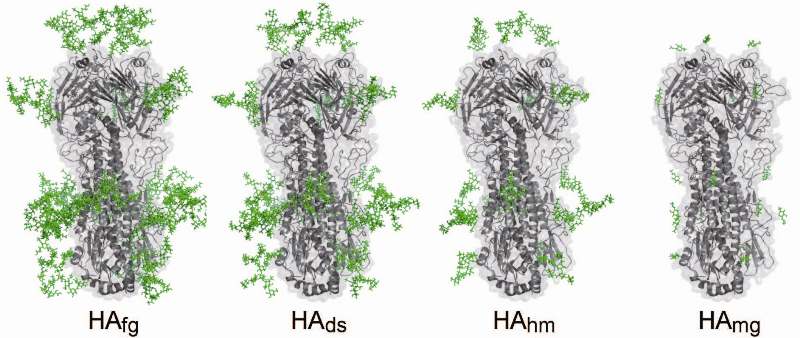In the latest online issue of PNAS, investigators of Genomics Research Center at Academia Sinica in Taiwan published a study that illustrates how in a quantitative proof, the size of the sugar molecules on the Hemagglutinin (HA) protein from influenza virus really matters. In lab, mice immunized with vaccine obtained from sugar-modified HA had a survival rate more than doubled comparing to non-modified counterparts. The study has demonstrated an important concept which is likely to be adopted as a new vaccine development strategy for influenza, hepatitis C and HIV vaccines.
 |
| From left, Hemagglutinin (HA) glycoprotein structures on which the glycans are reduced in size. |
By using the HA glycans as the studying object, the group used the H5N1 strains to explore its infectious behavior when the glycans on the HA glycoprotein are gradually trimmed from polysaccharides to monosaccharides. The test result indicated, as the sugar molecules were reduced in size, the binding force between HA and human cell receptor became stronger.
The group used the sugar chip which was also developed in GRC, and printed 24 different types of synthesized oligosaccharide molecules on the chip. They then inspected the binding force between these molecules and H5 molecules modified in various degrees. The result proved that the binding actions took place exclusively on 17 oligosaccharide molecules that mimic molecules in birds. Furthermore, of those who bind, the ones had the strongest binding were with least glycan sizes on HA.
This is a process that can be taken further to analyze what kind of human cells, or organs, are most vulnerable to the virus. It could shed light on the therapeutic studies. The clues could also lead ways to new drug developments and new diagnostics.
This research was originated purely from the scientific curiosities toward the role of “sugar” on the abundant (90%) HA on the surface of the influenza virus. The team took an approach to strip the larger “sugar” molecules like trimming trees. When finally all the larger “sugar” molecules were reduced to a monosaccharide form, similar to trees with all branches and leaves removed, the modified HA proteins showed the strongest binding force with cell receptors.
By injecting different versions of modified HA to lab mice as vaccines, they then exposed these mice to H5N1 virus in a dose equal to 100 times of LD50’s. (LD50 is a dosage measurement indicating a 50% survival rate.). The result showed none of the non-treated mice survived at day 9. That explains why when human beings were exposed to a high density of avian flu environment could still get infected and die. 20 % of the ones injected with original HA vaccine survived at day 14, yet, close to 50% of the ones injected with single-sugar HA survived at day 14.
According to Dr. Che Alex Ma, one of the corresponding authors of this publication, the conventional influenza vaccines are made from the whole virus. Since these oligosaccharide molecules attached to HA resemble those on human cell surface, they could easily fool the immune system to become unguarded when intruded. However, by using the modified HA molecule as the vaccine, the immune system can fully recognize the HA protein particularly at the regions where the amino-acid sequences show similarity among different flu strains, and result in an alerting system that won’t be confused by the sugar disguise. The same approach could work across strains like H1, H3 and H5, and possibly can be applied to other human viruses.
In July this year, Academia Sinica has already successfully transferred this technology to Opko Health, an US pharmaceutical company based in Miami.
The team is led by Dr. Chi-Huey Wong, other members include Dr. Che Alex Ma, Dr. Chung-Yi Wu, and several research specialists and students.